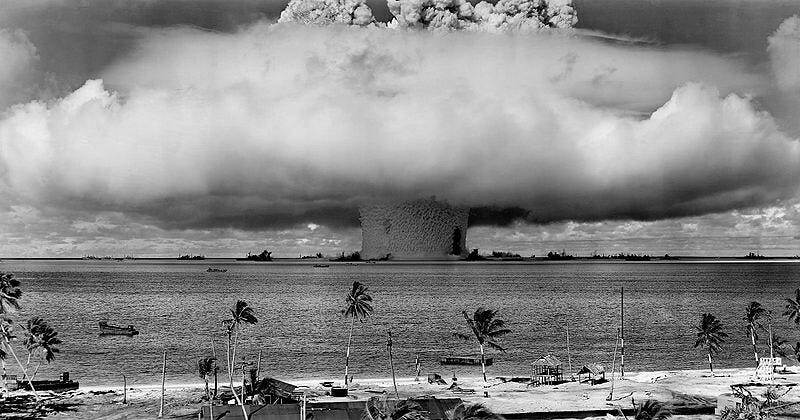First-time buyers Mark, 36, and Elena, 32, are looking for a three-bedroom, two-and-a-half bath home for them and their children, Ricky, seven, and Bobby, four.
The couple describe themselves as flexible about many things — pre-fab or custom, postwar or modern, ranch or split level — and flexible on price. But there’s one thing they’re not willing to compromise on — they just have to live at the site of a devastating nuclear disaster.
“For a lot of things, I’m really open-minded,” says Elena. “I don’t care what material, floors, kitchen appliances. But, there are certain things that I’m really picky about. It needs to be close to an international airport so I can go see my folks, it needs to have a good school system, and it needs to be on the site of a major nuclear disaster.”
The scale of nuclear devastation is important. Elena’s not willing to accept anything under a 10. “I’m sorry,” she says, “but this is my first home, and Fukushima’s not going to cut it.”
“I hate to admit that we’re that cliche of a young couple looking to buy in the dream place, with good schools, convenient location, and history of nuclear horror,” Elena says, “but we so are.”
They’ve been looking for a while, and they’ve hit a snag. While they’ve ruled out Ukraine (“Prices in Chernobyl have gotten outrageous,” Mark, a mechanical engineer, says, with a roll of the eyes), the two just can’t seem to agree—Hiroshima or Nagasaki?
Elena, an interior designer, favors Nagasaki. “Nagasaki has an incredible quality of life. It’s one of the best school districts in southern Japan, it has a thriving arts scene, and it’s really a buyer’s market right now. Also, close to 80,000 people died there during the nuclear bombing in 1945.”
“Elena, babe, that number’s way too high,” Mark says, with a shake of the head. “It was more likely closer to 39,000 or so.”
“That’s not true, Mark,” she says, rubbing at her temples. “Recent studies have confirmed that the devastation was much higher than initially assumed. I can’t believe we’re having this discussion again.”
“Sorry,” Mark says, giving me an apologetic look. “Sore subject.”
For his part, Mark favors Hiroshima.
“It just seems like a much better bet to me,” he says. “First off, it was the first city to be bombed, and the death total is upwards of 166,000. That was nearly half the population at the time — and 70 percent of the buildings were destroyed. I mean, this is our first home we’re talking about, hun. We can’t be fucking around with ‘maybe.’ When I see concrete numbers like that, they tell me, ‘Buy.’”
The two met at University College London ten years ago, when they were both enrolled in graduate programs. They met late one afternoon at a coffee shop, and soon discovered they shared a world in common, including a knack for design; a taste for Ethiopian food; and a love of Motown, documentaries, and — the one that made them both think, ‘twin flame’ — nuclear holocausts.
They were married a little over two years after they met, and vacationed on the Bikini Atoll, the site of the huge U.S. hydrogen bomb test in 1954.
“It was so romantic,” Elena shares. “The desertion, the Polynesian sunset, the lingering nuclear contamination. We could barely keep our hands off each other.”
“You know, the natives still won’t go back,” Mark says, with a smile. “Just incredibly romantic. It was like we were the only two people left in the world, everybody else singed, burned, evaporated in this nuclear oblivion, an atomic hell raining from the sky.”
“Atomic hell raining from the sky,” Elena repeats, resting her head on Mark’s shoulder. “That’s pretty. I need to write that down.”
Elena looks at me. “Sometimes I write poetry,” she says.
We take a look at several promising properties, including a three bedroom, two-and-a-half bath midcentury modern within their price range in Hiroshima; a three bedroom, three bath condominium in Nagasaki with a doorman and a private pool; and a palatial four bedroom, three-and-a-half bath in Hiroshima within the limits of one of the top school districts in Japan.
Unfortunately, the couple has problems with all of them.
The first place presents the timeless, intractable issue of paint color.
“Pea green? What were they thinking!” Elena says.
“They obviously weren’t,” Mark says, laughing at his own joke.
The second place has a coop board that is repulsed by Mark and Elena’s obsession with nuclear holocausts. The board unanimously rejects their application.
“You did go heavy on the nuclear content in the application, which I thought was extremely unnecessary and bizarre. And likely to tank your chances, as I said several times,” I say. “And now, here we are.”
“Screw them,” Elena says. “I hated the carpeting, anyway.”
The final place — a dream for a young family, with a formal dining room, living room, and big backyard — seems to be it. But there is a big red flag at the last minute: lead paint.
“I’m sorry,” Elena says. “I just can’t with the toxicity. I have two kids. End of story.”
The two are discouraged, but they won’t give up. Mark has gotten a lead from a colleague about another place that would be ‘perfect’ for his family. It’s in Nagasaki, but he’s decided to give it a look.
“If it’s as nice as he says,” Mark tells me, “and it’ll make my wife happy, then I’m happy.”
Mark pulls up an article on his iPad. “Hey babe, look what Dan from work sent.”
It’s an article from The New York Times, quoting industrial engineers who warn that New York’s Indian Point nuclear facility is ripe for a meltdown.
Elena smiles, giving Mark a peck on the lips.
“I know we’ll find our dream home,” Elena says. “It’s not a matter of if, but of when.”




